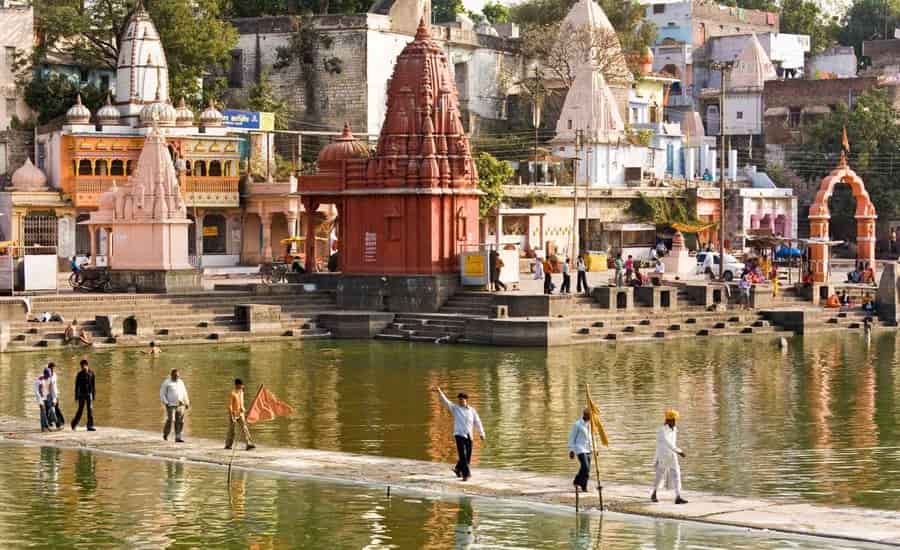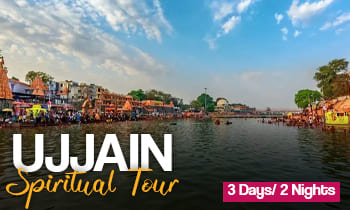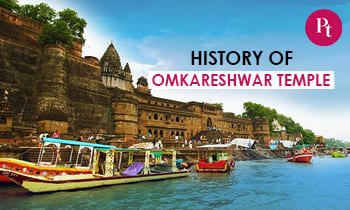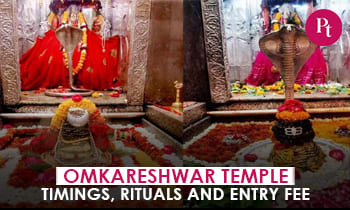Omkareshwar Temple, located in the Indian state of Madhya Pradesh, is one of the holiest and most revered pilgrimage sites for Hindus. This temple is dedicated to Lord Shiva, one of the principal deities in the Hindu pantheon. The temple’s location on an island in the Narmada River adds to its spiritual significance. In this comprehensive guide, we will explore the temple’s timings and rituals, shedding light on the religious practices that have been followed for centuries.
- Entry Fee: No entry fee
- Time Required: 1-2 hours

Temple Timings
Before delving into the intricacies of the rituals, it’s essential to know the temple’s timings to plan your visit effectively. Omkareshwar Temple generally follows a daily schedule, and it’s crucial to be aware of these timings to make the most of your spiritual journey:
- Morning Darshan: From 5:00 AM to 3:50 PM
- Evening Darshan: From 4:15 PM to 9:30 PM
- Mangal Aarti: From 5:00 AM to 5:30 AM
- Jalabhishek: From 5:30 AM to 12:25 PM
- Evening Aarti: From 8:20 PM to 9:05 PM
Aarti Timings
Aartis, or religious rituals involving the offering of lamps and prayers, are an integral part of the daily routine at Omkareshwar Temple. The temple conducts several aartis at different times of the day. Some of the significant aartis are:
- Mangal Aarti: This aarti takes place early in the morning before sunrise, usually around 5:00 AM. It is a serene and spiritually uplifting experience that marks the beginning of the day’s religious activities.
- Rudra Abhishek: Rudra Abhishek is a special puja performed to honor Lord Shiva. It is conducted around noon, typically at 12:00 PM.
- Sandhya Aarti: The evening aarti, known as Sandhya Aarti, is performed around sunset, approximately at 6:00 PM. This is a time when devotees gather to offer their prayers and seek Lord Shiva’s blessings.
- Shayan Aarti: The last aarti of the day, Shayan Aarti, takes place around 9:00 PM. It signifies the time for Lord Shiva to rest and is a peaceful way to conclude the temple’s daily rituals.
Daily Rituals
Omkareshwar Temple is steeped in traditions and rituals that have been followed for centuries. These rituals are a way for devotees to connect with the divine and seek the blessings of Lord Shiva. Here are some of the essential daily rituals observed at the temple:
Abhishek
- Abhishek is the ritualistic bathing of the deity with various sacred substances. In Omkareshwar Temple, Lord Shiva is bathed with milk, honey, ghee, and water while Vedic mantras are chanted. This ritual, known as Rudra Abhishek, is performed daily and is considered highly auspicious.
Aartis
- Aartis are performed throughout the day, as mentioned earlier. These rituals involve the offering of lamps, incense, and prayers to Lord Shiva. Devotees gather around the sanctum sanctorum to witness and participate in these aartis, which create a spiritually charged atmosphere.
Shivling Puja
- The main deity of Omkareshwar Temple is a sacred Shivling, a symbolic representation of Lord Shiva. Devotees can perform puja (worship) of the Shivling by offering flowers, bilva leaves, and holy water. This personal connection with the deity is an integral part of the temple’s daily rituals.
Bhajan and Kirtan
- Devotional songs, bhajans, and kirtans are regularly sung in the temple premises. These melodious tunes invoke a sense of devotion and inspire devotees to connect with the divine. Musicians and singers often perform in the temple, creating a vibrant and spiritual ambiance.
Prasadam Distribution
- After the aartis and pujas, prasadam (sacred food offerings) is distributed to the devotees. Partaking in this prasadam is considered a blessed act and is believed to purify one’s soul.
Parikrama (Circumambulation)
- Devotees often perform parikrama, which involves circumambulating the temple or walking around the sacred island. This act is seen as a way to seek the blessings of Lord Shiva and attain spiritual purification.
Special Occasions and Festivals
In addition to the daily rituals, Omkareshwar Temple hosts various special occasions and festivals that draw a multitude of devotees. These festivals are marked by elaborate rituals, grand processions, and an even more profound sense of spirituality. Some of the notable festivals celebrated at the temple are:
Mahashivratri
- Mahashivratri is one of the most significant festivals dedicated to Lord Shiva. It falls on the 14th day of the dark fortnight in the month of Phalgun (usually February or March). The festival is celebrated with great enthusiasm at Omkareshwar Temple, and devotees throng the temple for all-night prayers, bhajans, and abhishek.
Karthik Purnima
- Karthik Purnima is another auspicious occasion when the temple witnesses a surge in devotees. On this day, a grand aarti is performed, and the temple is beautifully illuminated with lamps and candles.
Shravan Month
- The entire month of Shravan (usually falling in July or August) is dedicated to Lord Shiva. Devotees observe fasts, visit the temple regularly, and perform abhishek on Mondays, considered especially auspicious for Lord Shiva.
Narmada Jayanti
- Narmada Jayanti is the birthday of the sacred Narmada River. Devotees take a holy dip in the Narmada and offer prayers at the temple to seek the river’s blessings and Lord Shiva’s grace.
Deepavali
- The festival of Deepavali, or Diwali, is celebrated with fervor at Omkareshwar Temple. The temple is adorned with colorful decorations and lamps, and the entire island comes alive with joy and festivities.
These festivals are a testament to the rich cultural and religious heritage of Omkareshwar Temple, attracting not only local devotees but also pilgrims from different parts of India and around the world.
Dos and Don’ts for Devotees:
To ensure a respectful and harmonious experience at Omkareshwar Temple, it’s important for devotees to adhere to certain guidelines:
Dos:
- Maintain cleanliness and hygiene while visiting the temple.
- Dress modestly and appropriately, covering your shoulders and knees, as a mark of respect.
- Follow the temple’s rules and timings for darshan and rituals.
- Offer your prayers with devotion and sincerity.
- Be respectful to fellow devotees and the temple staff.
- Partake in prasadam as a gesture of gratitude.
- Participate in the aartis, bhajans, and kirtans with enthusiasm.
- Support the local economy by purchasing items from authorized shops within the temple complex.
Don’ts:
- Avoid carrying or consuming non-vegetarian food or alcohol within the temple premises.
- Refrain from smoking or using tobacco products in the temple area.
- Do not engage in loud or disruptive behavior.
- Do not touch the sacred idols or Shivling without permission.
- Do not engage in commercial activities or solicitations within the temple premises.
- Refrain from taking photographs or videos without permission, as some areas may be restricted.
Conclusion
Omkareshwar Temple, dedicated to Lord Shiva, is a place of immense spiritual significance and cultural heritage. The temple’s daily rituals and special festivals provide devotees with the opportunity to connect with the divine and seek blessings. By following the temple’s dos and don’ts and understanding the facilities available, you can make your visit a memorable and fulfilling experience. Plan your trip to Omkareshwar Temple, immerse yourself in its rich traditions, and embark on a spiritual journey that will leave a lasting impact on your life.










 Call
Call WhatsApp
WhatsApp Enquiry
Enquiry
Any Special Entry or Any sort of Quick Darshan Facility Abl in
How to take darshan on Sunday??